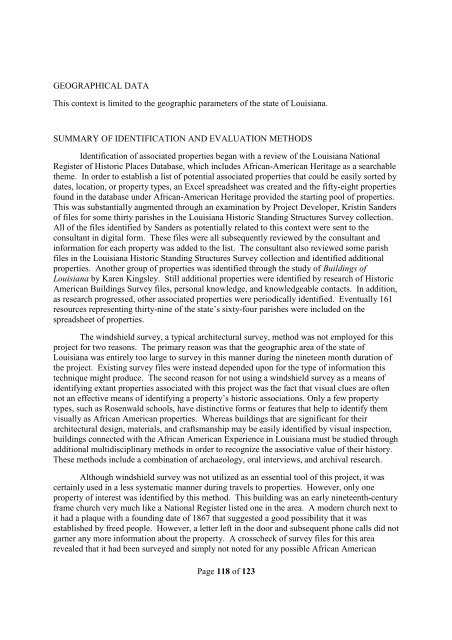The African American Experience in Louisiana
The_African_American_Experience_in_Louisiana
The_African_American_Experience_in_Louisiana
- No tags were found...
Create successful ePaper yourself
Turn your PDF publications into a flip-book with our unique Google optimized e-Paper software.
GEOGRAPHICAL DATA<br />
This context is limited to the geographic parameters of the state of <strong>Louisiana</strong>.<br />
SUMMARY OF IDENTIFICATION AND EVALUATION METHODS<br />
Identification of associated properties began with a review of the <strong>Louisiana</strong> National<br />
Register of Historic Places Database, which <strong>in</strong>cludes <strong>African</strong>-<strong>American</strong> Heritage as a searchable<br />
theme. In order to establish a list of potential associated properties that could be easily sorted by<br />
dates, location, or property types, an Excel spreadsheet was created and the fifty-eight properties<br />
found <strong>in</strong> the database under <strong>African</strong>-<strong>American</strong> Heritage provided the start<strong>in</strong>g pool of properties.<br />
This was substantially augmented through an exam<strong>in</strong>ation by Project Developer, Krist<strong>in</strong> Sanders<br />
of files for some thirty parishes <strong>in</strong> the <strong>Louisiana</strong> Historic Stand<strong>in</strong>g Structures Survey collection.<br />
All of the files identified by Sanders as potentially related to this context were sent to the<br />
consultant <strong>in</strong> digital form. <strong>The</strong>se files were all subsequently reviewed by the consultant and<br />
<strong>in</strong>formation for each property was added to the list. <strong>The</strong> consultant also reviewed some parish<br />
files <strong>in</strong> the <strong>Louisiana</strong> Historic Stand<strong>in</strong>g Structures Survey collection and identified additional<br />
properties. Another group of properties was identified through the study of Build<strong>in</strong>gs of<br />
<strong>Louisiana</strong> by Karen K<strong>in</strong>gsley. Still additional properties were identified by research of Historic<br />
<strong>American</strong> Build<strong>in</strong>gs Survey files, personal knowledge, and knowledgeable contacts. In addition,<br />
as research progressed, other associated properties were periodically identified. Eventually 161<br />
resources represent<strong>in</strong>g thirty-n<strong>in</strong>e of the state’s sixty-four parishes were <strong>in</strong>cluded on the<br />
spreadsheet of properties.<br />
<strong>The</strong> w<strong>in</strong>dshield survey, a typical architectural survey, method was not employed for this<br />
project for two reasons. <strong>The</strong> primary reason was that the geographic area of the state of<br />
<strong>Louisiana</strong> was entirely too large to survey <strong>in</strong> this manner dur<strong>in</strong>g the n<strong>in</strong>eteen month duration of<br />
the project. Exist<strong>in</strong>g survey files were <strong>in</strong>stead depended upon for the type of <strong>in</strong>formation this<br />
technique might produce. <strong>The</strong> second reason for not us<strong>in</strong>g a w<strong>in</strong>dshield survey as a means of<br />
identify<strong>in</strong>g extant properties associated with this project was the fact that visual clues are often<br />
not an effective means of identify<strong>in</strong>g a property’s historic associations. Only a few property<br />
types, such as Rosenwald schools, have dist<strong>in</strong>ctive forms or features that help to identify them<br />
visually as <strong>African</strong> <strong>American</strong> properties. Whereas build<strong>in</strong>gs that are significant for their<br />
architectural design, materials, and craftsmanship may be easily identified by visual <strong>in</strong>spection,<br />
build<strong>in</strong>gs connected with the <strong>African</strong> <strong>American</strong> <strong>Experience</strong> <strong>in</strong> <strong>Louisiana</strong> must be studied through<br />
additional multidiscipl<strong>in</strong>ary methods <strong>in</strong> order to recognize the associative value of their history.<br />
<strong>The</strong>se methods <strong>in</strong>clude a comb<strong>in</strong>ation of archaeology, oral <strong>in</strong>terviews, and archival research.<br />
Although w<strong>in</strong>dshield survey was not utilized as an essential tool of this project, it was<br />
certa<strong>in</strong>ly used <strong>in</strong> a less systematic manner dur<strong>in</strong>g travels to properties. However, only one<br />
property of <strong>in</strong>terest was identified by this method. This build<strong>in</strong>g was an early n<strong>in</strong>eteenth-century<br />
frame church very much like a National Register listed one <strong>in</strong> the area. A modern church next to<br />
it had a plaque with a found<strong>in</strong>g date of 1867 that suggested a good possibility that it was<br />
established by freed people. However, a letter left <strong>in</strong> the door and subsequent phone calls did not<br />
garner any more <strong>in</strong>formation about the property. A crosscheck of survey files for this area<br />
revealed that it had been surveyed and simply not noted for any possible <strong>African</strong> <strong>American</strong><br />
Page 118 of 123


